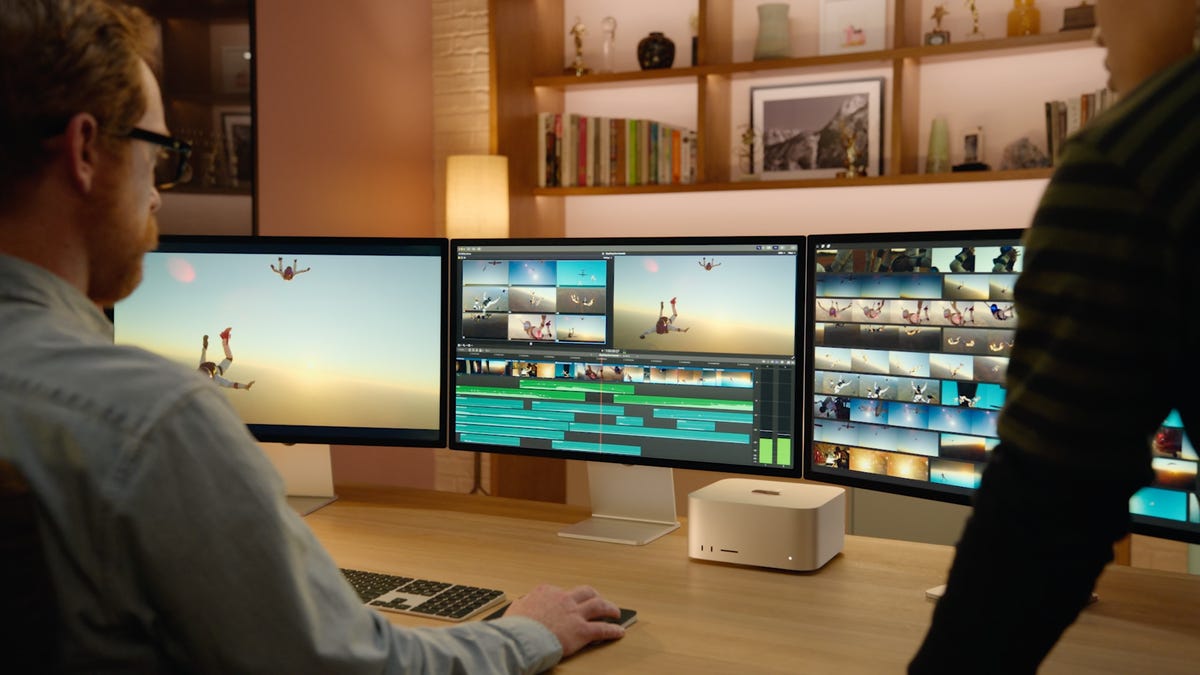Mac Studio Ports: Everything You Can Plug Into This New Apple Device
Apple unveiled the Mac Studio at its iPhone SE event. Here's everything you can connect to the new device.

The Mac Studio is a compact, standalone computer for creative professionals.
During Apple's Peek Performance product launch event on Tuesday, the tech giant introduced the Mac Studio, a small, standalone computer designed for creative professionals. The Mac Studio, with the accompanying Studio Display, offers performance, connectivity and modularity for musicians, photographers, videographers and engineers. The Mac Studio starts at $1,999 (£1,999, AU$2,499) and will be available from March 18. Preorders are open now.
The Mac Studio is also loaded with connectivity ports on the front and back. Multiple ports make it easier for people to multitask and customize workspaces to best fit their needs. The Mac Studio has a total of 12 ports -- nine on the back and three on the front.
Here's a breakdown of every port on the Mac Studio:
Thunderbolt 4 ports
What they do: A Thunderbolt 4 cable lets you connect external monitor displays, USB devices and more. Thunderbolt ports provide enough bandwidth for connecting high-speed devices and more easily support high-powered and resource-hungry equipment.
Where they are: The Mac Studio has four Thunderbolt 4 ports on the back.
Bottom line: The Mac Studio's multiple Thunderbolt 4 ports mean more ways to connect devices without having to worry about any of your tech slowing down.
The HDMI port is next to the four Thunderbolt 4 ports on the Mac Studio.
Ethernet port
What it does: An Ethernet port (also known as a socket or jack) creates an Ethernet connection between computers, servers, routers, gaming consoles, printers and more. Ethernet can also help you connect to the internet if you're not using Wi-Fi.
Where it is: You'll find the Mac Studio's Ethernet port on the back.
Bottom line: The Mac Studio offers a 10GB Ethernet port, which means users can transfer and convert files faster.
USB-A ports
What they do: USB-A ports and cables work the same as USB-C, but are generally found on older devices. Like USB-C, USB-A can be used for charging or connecting separate devices.
Where they are: You can find two USB-A ports on the back of the Mac Studio.
Bottom line: If you get a Mac Studio, you'll be able to hook up some of your older tech without having to buy an adapter.
USB-C ports
What they do: USB-C ports and cables are like USB-A, but for newer technology. These ports can be used to connect and charge external devices like phones or cameras.
Where they are: The Mac Studio has two USB-C ports on the front of the device.
Bottom line: Apple said it placed these two ports on the front of the Mac Studio for quick access and changes to devices. If you're using an M1 Mac, these ports operate at 10 Gbit/s data transfer rate. If you'll be using Macs equipped with the new M1 Ultra chip, Apple says the ports are Thunderbolt 4. This means up to 40 Gbit/s data transfer speeds..
Two USB-A ports, an HDMI port and a headphone jack are also on the back of the Mac Studio.
HDMI port
What it does: HDMI ports connect with HDMI cables to send and receive video and audio between external devices, like displays and TVs.
Where it is: An HDMI port is available on the back of the Mac Studio.
Bottom line: The Mac Studio's HDMI port is another way for users to expand their work setup for maximum efficiency.
Headphone jack
What it does: Headphone ports let you connect external headphones using a cable, instead of wirelessly with Bluetooth. This may be an advantage if you want to use a favorite pair of wired headphones as your main pair or as a backup if your wireless headphones are charging.
Where it is: The headphone jack is on the back of the Mac Studio.
Bottom line: The Mac Studio headphone jack is also a pro audio jack. This means it supports high impedance headphones or external speakers.
Two USB-C ports and an SD card slot are easily accessible on the front of the Mac Studio.
SDXC slot
What it does: An SD card slot gives you fast access to media. For example, if you're a photographer, you can insert the SD card from your DSLR camera into the MacBook Pro slot to view your images.
Where it is: The Mac Studio has an SD card slot on the front.
Bottom line: Apple is marketing the Mac Studio for creative professionals, with special tech for photographers and videographers, so the device offers fast access to camera memory cards and external storage.
For more information, check out everything announced at the Apple Event and what to know about the new iPhone SE.

